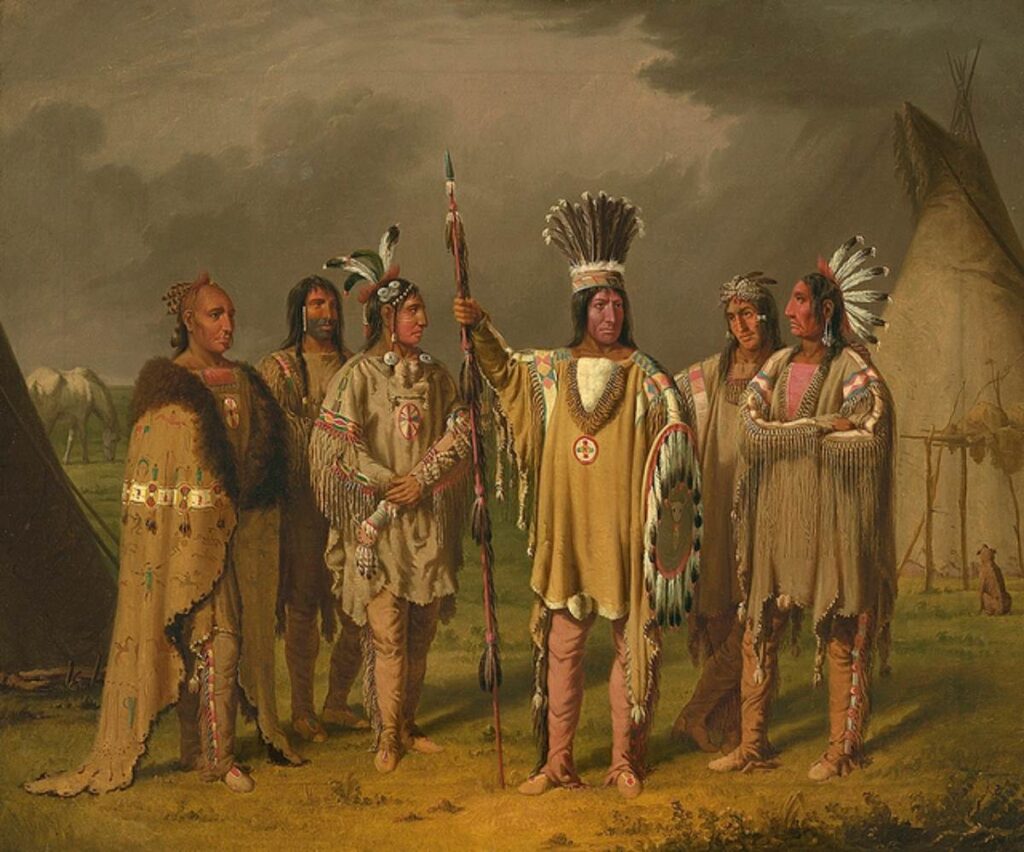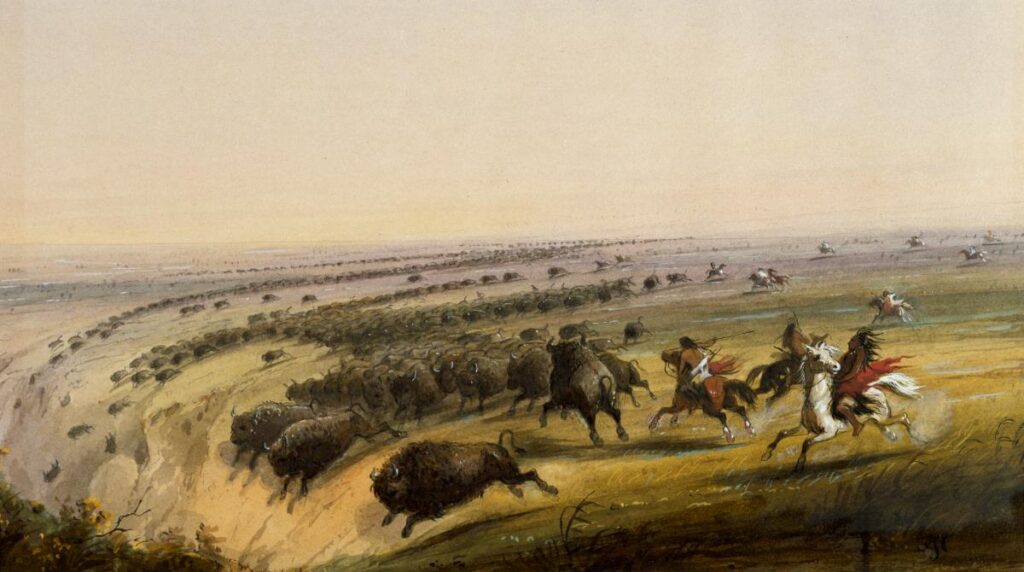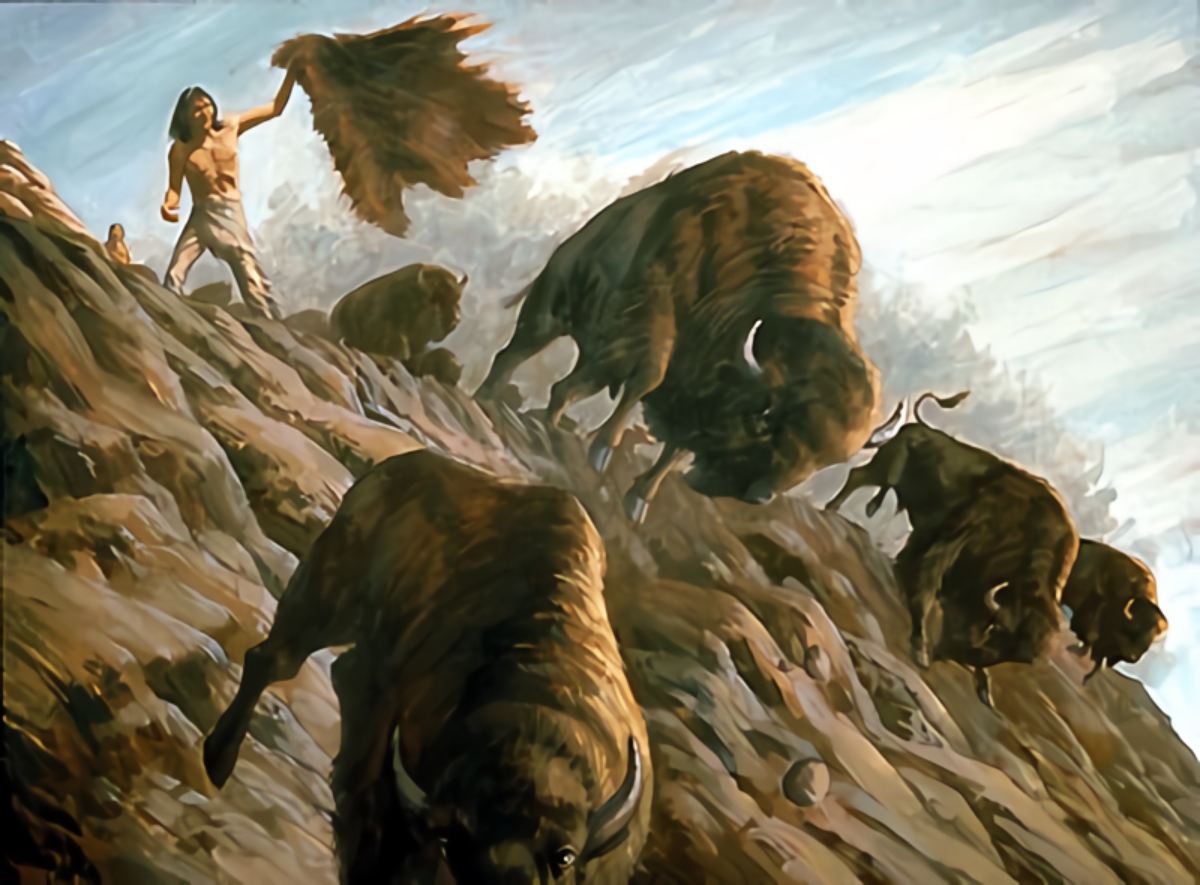For thousands of years, indigenous people on the northern plains known as the Blackfeet tribe (really “Blackfoot” since the term in Siksika is singular) drove bison over cliffs. Buffalo hunting gave the Blackfoot everything they needed to live. A large granite face rises from the plains in southern Alberta. The sandstone cliffs dominate the picture from several miles away while approaching the Rocky Mountains from the east. The plains look to continue forever from the Rocky Mountains. It culminates in cliffs where the granite drops nearly as steeply. Bison were originally driven here by Blackfoot tribes. Panicked animals leaped from the cliff into their deaths. Head-Smashed-In Buffalo Jump was used as a slaughterhouse for around 6,000 years and is now a heritage site.
Buffalo skulls and bones piled up at the bottom of the 32-foot (10-meter) sandstone wall when Junius Bouton Bird of the American Museum of Natural History began digging there in 1938. Stone instruments were used by hunter-gatherers to carve their victims. Since then, scientists have found how Stone Age hunters trapped and processed animals. Several Blackfoot tribes of 80–240 people worked together to achieve the hunt.
Throughout history, hunting influenced the civilizations of these people. Buffalo-themed songs, art, beliefs, and mythology on the Buffalo Head-Smashed-In Jump’s sandstone cliffs are remnants of a highly sophisticated culture like Egypt’s pyramids, India’s Taj Mahal, and Peru’s Machu Picchu. In 1981, they were designated as a UNESCO World Heritage Site.
UNESCO added another Blackfoot site 125 miles (200 km) east in July 2019: Áísínai’pi, or Writing-on-Stone, is a park with several sandstone hoodoos sculpted by wind and water. On rock walls, over 100 Blackfoot figures are painted or carved. The hoodoos were revered by the Blackfoot. The Shoshone tribe, whose hunting grounds encircled Blackfoot, might have drawn here as well.
Rock Structures From the Ice Age

The cult site was formed from the remains of a massive lake 85 million years ago when dinosaurs roamed the Earth. The pressure exerted by the overlying masses compacted the sand at the bottom of the body of water, transforming it into sandstone. Massive amounts of water eroded the sandstone as the last Ice Age glaciers receded 20,000 years ago.
Writing-on-Stone Provincial Park is located in one of these glacier valleys. Its northern bank is bounded by sandstone cliffs. Because of the “rain shadow” cast by the Rocky Mountains, the prairies are parched. Rain can wash porous sandstone cliffs into the Milk River.
The sun heats the area to 104°F (40°C) in the summer, while arctic air cools it to -40°F (-40°C) in the winter. The temperature differential and intense frost pulled pieces of the cliff away, resulting in strange rock formations. Prairie winds also sandblasted the rocks, carrying the sand away. This resulted in the formation of hoodoos, which typically consist of a hat-like, hard stone spire and a slender sandstone column.
For 4,000 years, Stone Age hunter-gatherers concealed themselves from the wind by hiding under hoodoos. The Blackfoot, and less often the Shoshone, Cree, and Assiniboine, journeyed to the Milk River, where beavers built dams and where species like mule deer still live today.
These animals were less difficult to dispatch than the big buffalo. The native people wrote about hunting bison, mule deer, and beaver in hoodoos, as well as some heroic actions and European colonization. The drawings were created by the Blackfeet or Blackfoot people using buffalo grease and red soil. Archaeologists are continuously discovering fresh petroglyphs today.
The Ford T in the Sandstones

The ages of these Blackfeet artworks are simply estimates. Around 1730, the Shoshone brought horses to the region. Around 1750, the Blackfoot started to hunt buffalo on horseback. Hunters probably employed buffalo-hide shields before 1750, as shown by petroglyphs. Personal insignia, similar to European coats of arms, are often displayed on the shields.
In those images, native folks raise their arms. Others, most likely dancers, support themselves on their hips or knees. Archaeologists are baffled by the pictures, but Blackfoot elders recognize their importance and refuse to share them with non-native Canadians.
A rock sculpture resembling a Ford T has been decoded by experts. Between 1908 and 1927, 15 million were produced in the United States. A Blackfoot dubbed “Bird Rattle” traveled from a Montana reservation to the Milk River hoodoos in September 1924 and carved a vehicle into the rock.
The Dangers of Buffalo Hunting

Writing-on-Stone was a spiritual and cultural center for the Blackfoot, but Head-Smashed-In Buffalo Jump depicts aboriginal life before horses and weapons. The buffalo hunt was more difficult and deadly back then. The shoulder height of a bison bull is 5.75 feet (1.75 meters), putting it at eye level with a human. Bison may grow to be 10 feet (3 meters) tall and weigh up to 1800 pounds (800 kilos).
Buffalo calves were easier to hunt since they were half the size of humans. The 40-pound (18-kg) calves remained close to their mother for a year while being fully protected by her. However, even one-year-old bison weighing 450 to 650 pounds (200 to 300 kg) are not easy prey, so hunting buffalo was always tough until the Blackfoot began using horses and weaponry about 1750. Although bison were difficult to kill, aboriginal Americans such as the Blackfoot prized their meat, fat, hides, skins, bones, and horns.
Using Bison and Wolf Masks
Bison hunting was difficult for indigenous Canadians since the animals roamed in herds in Alberta and Montana. Because there were few trees on these plains, hunters like Blackfoot couldn’t sneak up on animals. The best time for this was about midday. On the grass, bison sat and chewed their cud. Because buffalo can’t see well in the wind, Blackfoot hunters approached them against the wind and on their knees.
A stalking hunt by a Blackfoot family provided food for many days. However, this method was not producing enough prey for the winter. Thus, hunter-gatherers in what is now Texas drove bison off a cliff 10,000 years ago to capture a large number of them at once.
Head-Smashed-In Buffalo is 32 feet (10 meters) tall. The Jump strata features the region’s first mass hunt evidence. Using C14 carbon dating, deep bison bones were dated at 5800 years. By that time, aboriginal hunter-gatherers were chasing bison over cliffs to hunt them all at once. Two stone spearheads discovered in a neighboring stream valley show that early people similar to the Blackfoot civilization were in the region 9000 years ago. It’s unclear if they were just passing by, setting up their winter camp in the canyon, or hunting on the cliffs.
Bow and Arrow Hunting, Spear Slings, and the Sandstone Cliff

The “stone tips” that were found with the buffalo bones under the cliff help to figure out how the Blackfoot tribe hunted. The tips are from stone arrows (or spearheads), indicating that when the buffalo survived the fall, the Blackfoot generally ended it with a bow and arrow. The oldest stone tools date back more than 1700 years. Before it, they used spear throwers.
The 1,6-foot (0.5-meter) sticks helped in the lengthening of the throwing arm and accelerated the wooden spears to approximately 90 miles per hour (150 km per hour). They were more powerful than a hand-thrown spear. This technique was developed by Head-Smashed-In Buffalo Jump 5800 years ago. And the locals did not employ spear throwers until 4200-3200 years ago since no spear points until this period were discovered on sandstone cliffs.
The Stone Age inhabitants drove buffalo over cliffs only at a certain time of year and established a large butchery in the fall. The reason was that the calves born in the spring were half a year old at this time, and the juvenile buffaloes were 1.5–2 years old. These ages were determined by experts using fossilized teeth since other animal remains are uncommon.
The buffalo had congregated in a hollow west of the cliffs before the fall hunt. The groundwater was high there, and fresh, healthy grass sprang abundantly. The Blackfoot shamans and elders agreed to begin the hunt if the weather was fair and the wind blew in such a manner that the animals didn’t notice the humans. However, this only occurred every few years. After all, there were additional “Buffalo Jump” stone cliffs found on the plains. However, the Stone Age slaughterhouse at Head-Smashed-In is the best preserved and reveals the most about Blackfoot hunting methods.
“Dead Men” Stones as Buffalo Scarecrows
The bison that roamed in the depression were in excellent condition. They’d put on winter fat and grow a thick coat. The Blackfoot got ready for the hunt by making a trail from the valley to the cliffs. Every few feet, they laid stones along the route. They were dubbed “death men” by Blackfoot. Many of them are still standing today, reminding us of Stone Age times. Small bushes were put into the piles to provide hair for the buffalo scarecrows. And the bison was terrified of this.
According to Blackfoot folklore, young Blackfoot males called “buffalo runners” came up behind the herd. They were dressed in animal skins. The buffalo were worried but not scared. They continued to graze while avoiding the disguised “dead men.” Animals cautiously approached the cliffs along these guardrails.
The Blackfeet men crept in front of the herd, dressed in bison calf skins and greased with bison fat. Thus, they stunk like buffalo. When they bleated like calves, the cows rushed to their aid. From behind the cairns, shouting Blackfoot men waved buffalo skins just before the edge. As a consequence, terrified bison stampeded. The animals were unable to halt at the cliff’s edge and fell to their deaths.
The cliffs were 65 feet (20 meters) high 5800 years ago, and most buffalo died as a result of the falling. The cliffs have stayed about 33 to 36 feet (10 or 11 meters) in height over time due to the accumulation of bones in the area.
Butchering of Prey
Blackfoot hunters utilized spearguns or bows and arrows to kill the animals below the cliffs. Then the real job began. Some of the stone rings that held Blackfoot tents to the ground are still visible today. Hundreds of Blackfoot people peeled bison skins using stone scrapers.
After the animal was hacked up, sinews and bones were used to make thread and tools. The Blackfeet used stone knives to cut buffalo meat into thin strips, which they sun-dried on wooden racks. To get the marrow, bison leg bones were shattered. They burned stones in a pit lined with fresh buffalo leather to remove fat from bone fragments.
From this, entrail tallow, and powdered beef pieces, the Blackfoot kneaded pemmican. Dried berries were used as a seasoning. The thing about Pemmican is that it preserves well and is nutritious. The Blackfoot were able to endure the winter because of this shelf-stable food. They ate it this way or dissolved it in hot water like instant soup.
The End of a Lifestyle
In 1874, the Royal Canadian Mounted Police (RCMP) established its first post in Blackfeet territory, and European settlers quickly followed. By 1881, bison were almost extinct. After losing their livelihood, the Blackfoot adapted to a new environment. Today, about 30,000 Blackfoot people live in Montana and Alberta, farming, raising cattle, and manufacturing crafts. Others are still unaware of their 1,000-year-old bison-centered lifestyle.
Sources and further reading:
- Dempsey, Hugh A. “Blackfoot Confederacy”. The Canadian Encyclopedia.
- Grinnell, George Bird (1892). “Early Blackfoot History”. American Anthropologist.
- West, Helen B. (Autumn 1960). “Blackfoot Country”.


